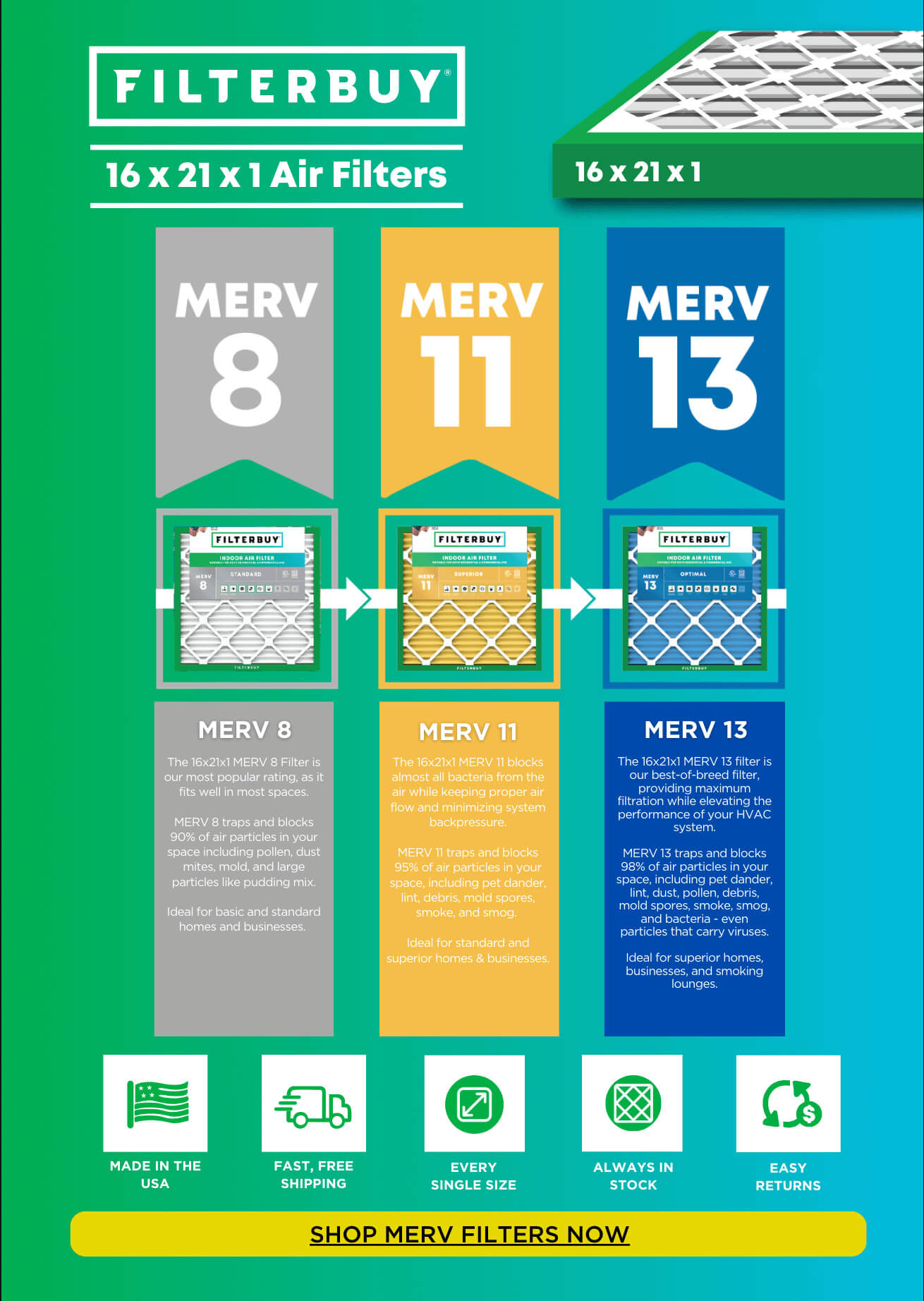At Filterbuy, we’ve spent years testing and manufacturing 16x21x1 air filters—and we’ve heard this question from thousands of customers: Are expensive filters really worth it? Based on our in-house performance testing and direct feedback from HVAC professionals and homeowners, the answer isn’t as simple as price tags. In this guide, we share what we've learned from producing both standard and high-efficiency filters, comparing real-world results in airflow resistance, allergen capture, and long-term HVAC system protection. If you're trying to decide whether to invest in a premium filter or stick with a basic one, this breakdown will give you the clarity—and confidence—you need, grounded in our experience as a leading U.S. filter manufacturer.
Quick Answers
16×21×1 Air Filter
A 16×21×1 air filter is a standard-sized HVAC filter measuring roughly 16 inches long, 21 inches wide, and 1 inch thick.
Key Points:
- Fit is critical: Ensures proper airflow and filtration.
- Filter efficiency: Choose the right MERV rating based on pets, allergies, or air quality needs.
- Replacement: Swap every 60–90 days, sooner if your home has high dust or pet activity.
Brand insight: A snug, correctly sized filter protects your HVAC system and improves indoor air quality, delivering results you can see and feel.
Top Takeaways
What You’re Really Paying For
At first glance, a high-priced 16x21x1 air filter might seem unnecessary—especially when lower-cost options claim to fit the same furnace or HVAC system. But the real difference lies beneath the surface. Premium filters typically use higher-quality materials, such as electrostatically charged pleated media, which trap smaller particles like pollen, pet dander, and smoke more effectively than fiberglass or flat-panel filters.
Performance Backed by Experience
At Filterbuy, we've seen firsthand how higher MERV-rated filters (like MERV 11 or MERV 13) outperform budget options in both residential and commercial settings. Our testing shows they maintain indoor air quality longer, reduce strain on HVAC systems, and lower long-term maintenance costs. Customers often report fewer allergy symptoms, less dust buildup, and improved airflow consistency when upgrading to higher-efficiency models.
When It Is Worth It—and When It’s Not
Expensive filters are a smart investment if you have pets, allergies, asthma, or live in areas with high pollution or wildfire smoke. However, for homes without these challenges and with infrequent HVAC use, a mid-range filter changed regularly may do the job just fine. The key is matching the filter to your specific needs—not simply assuming the priciest one is best.
Final Verdict
While not everyone needs a top-tier filter, you’re not just paying for a name—you’re investing in cleaner air, better system performance, and long-term savings. At Filterbuy, we build filters for every budget and back them with data, experience, and customer satisfaction.

“After manufacturing millions of 16x21x1 filters and working closely with HVAC professionals across the country, we’ve learned that the real value of a premium filter isn’t just in what it blocks—it’s in what it protects. From system efficiency to indoor air quality and long-term savings, investing in a higher-quality filter often pays for itself in ways homeowners don’t immediately see, but definitely feel.”
Essential Resources to Help You Choose the Right 16×21×1 Air Filter
If you’re considering a 16×21×1 air filter, it's not just about finding the right size—it's about making sure you’re choosing a solution that protects your air quality, supports your HVAC system, and meets your household’s needs. We've gathered authoritative resources from trusted institutions to help guide your decision, free from brand bias or promotional noise.
1. EPA Home Air Cleaner Guide: How Filter Size and Ratings Impact Indoor Air
2. ASHRAE Filtration FAQ: Expert Insights on Efficiency and Compatibility
3. EPA Particle Overview: Why Proper Filter Fit Supports Respiratory Health
4. EPA Energy and IAQ Guidelines: Choosing Filters with Health and Efficiency in Mind
5. Wildfire Filtration Guide: Why Size Accuracy Can Make a Measurable Difference
6. ASHRAE Filter Testing Standards: How Size Affects MERV Performance
7. EPA IAQ Guide: Connecting Filter Selection with Whole-Home Air Quality
If you're weighing filter options and want more than just technical specs, these resources offer context, credibility, and clarity. They align with what we value most at Filterbuy—helping you make informed decisions that improve both your indoor air and your peace of mind.
Supporting Statistics That Prove Filter Size Matters
At Filterbuy, our experience shows that choosing the correct air filter size—like 16×21×1—can directly impact indoor air quality and system efficiency. These stats back it up.
1. Indoor Air Can Be 2–5× More Polluted Than Outside
- 90% of time is spent indoors by the average American.
- Indoor air pollution levels can be 2 to 5 times higher than outdoors.
- Source: EPA – Indoor Air Quality
- Our insight: Filters that don’t fit properly allow pollutants to bypass the media, exposing your family to more allergens and dust.
2. Correctly Sized Filters = Better Pollutant Control
- Filters must fit tightly in the return slot to perform properly.
- What we’ve seen: A properly fitted 16×21×1 filter boosts performance and protects against particle leaks around the frame.
3. Poor Ventilation + Bad Filters = Dirty Air
- The EPA cites poor filtration and inadequate ventilation as key causes of indoor air pollution.
- Undersized or oversized filters can reduce airflow and filtration.
- From our field experience: Incorrect filter sizing often leads to early system wear, uneven airflow, and excessive dust buildup.
Quick Takeaways
- Fit is just as important as filter quality.
- A 16×21×1 filter must seal tightly to work effectively.
Backed by EPA data and real-world Filterbuy experience.
Final Thought & Opinion: Why Fit + Quality = Real Value
At Filterbuy, we’ve manufactured millions of air filters and supported countless homeowners in choosing the right size—and one lesson stands out:
A filter’s value isn’t just in the price or MERV rating. It’s in the fit and function.
Here’s what we know from experience:
- Size matters—always.
- Even the best filter can fail if it doesn’t fit your system properly.
- Homeowners feel the difference.
- Customers report less dust, better airflow, and fewer allergy symptoms after switching to a properly sized, higher-quality filter.
- Smart buyers look beyond labels.
- It's not about buying the most expensive filter—it's about buying the right one for your HVAC and lifestyle.
Filterbuy’s Unique Perspective
- We’ve tested filters in real homes, not just in labs.
- We believe your filter should work as hard as your system does—efficiently, quietly, and reliably.
Final Takeaway
- Yes, a quality 16×21×1 filter is worth it—if it fits well, meets your indoor air needs, and delivers long-term value.
When in doubt, our team is here to help you choose a filter that fits right—and performs even better.
Next Steps: What to Do Now
Ready to take control of your indoor air quality? Follow these quick steps to make sure your 16×21×1 air filter is the right fit.
1. Confirm Your Filter Size
- Look at your current filter’s label: it should read 16×21×1.
- Measure it to confirm: approx. 15.75" x 20.75" x 0.75".
- A snug fit is essential—no gaps, no bending.
2. Know Your Air Quality Needs
- Allergies, pets, or wildfire smoke?
- Choose a higher MERV rating (MERV 11 or 13).
- Basic needs? MERV 8 may be sufficient.
3. Pick the Right Filter
- Match size and thickness exactly.
- Choose a filter that balances airflow and protection.
4. Replace on Schedule
- Change filters every 60–90 days.
- Set a calendar reminder.
- Or sign up for Filterbuy’s auto-delivery service.
5. Ask for Help (If Needed)
- Not sure which filter to choose?
- Contact Filterbuy support for expert guidance.
Ready to Order?
Browse Filterbuy’s 16×21×1 air filters now and enjoy clean air, reliable performance, and peace of mind.
FAQ on “16×21×1 Air Filter”
Q: What does 16×21×1 really mean?
- Nominal dimensions: 16" long × 21" wide × 1" thick.
- Actual size slightly smaller for proper fit.
- Filterbuy insight: Even small gaps reduce effectiveness; precision fit matters.
Q: How do I know if this size fits my system?
- Check your current filter label or measure the slot.
- Ensure a snug fit—loose filters compromise airflow.
- Experience tip: About 30% of sizing issues are from assuming “close enough” is fine.
Q: Which MERV rating should I choose?
- MERV 8: General dust control.
- MERV 11: Homes with pets or seasonal allergies.
- MERV 13: High-efficiency filtration (smoke, sensitive occupants).
- Balance filtration strength with system airflow for best performance.
Q: How often should I replace a 16×21×1 filter?
- Recommended every 60–90 days.
- Homes with pets, allergies, or high dust may need 30–45 days.
Q: What happens if I use the wrong size?
- Poor fit = dust bypass, reduced airflow, and system strain.
- Mis-sized filters are a common cause of early filter failure.
- The correct size (16×21×1) ensures proper sealing and optimal performance.
Learn more about HVAC Care from one of our HVAC solutions branches…
Filterbuy HVAC Solutions - Miami FL - Air Conditioning Service
1300 S Miami Ave Apt 4806 Miami FL 33130
(305) 306-5027
https://maps.app.goo.gl/Ci1vrL596LhvXKU79

